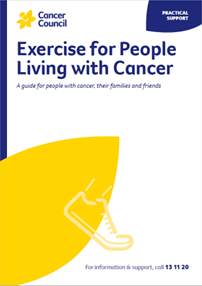- Home
- About Cancer
- Living well
- Exercise for people living with cancer (with videos)
- Flexibility (video)
Flexibility exercises
Flexibility exercises, also known as stretches or range-of-motion (ROM) exercises, lengthen muscles and tendons.
Learn more about:
Watch videos on these exercises:
Shoulder stretch Triceps stretch Pectoral and biceps stretch Quadriceps stretch Calf stretch Hamstring stretchRemember to check with your health care team before beginning any exercise program. Although we have included flexibility exercises to suit most people, some may not be right for you.
Overview
Flexibility exercises improve or maintain the flexibility of joints and muscles. We naturally lose joint and muscle flexibility as we age, but cancer treatments also contribute to this. Regular stretching helps to improve stiffness and flexibility.
This section has simple flexibility exercises you can do at home. You could also join an exercise class that focuses on stretching, such as an easy yoga class. Check with your health professional before doing any exercise – these exercises suit most people, but may not be safe for you.
How much exercise should I do?
Try to do flexibility exercises 3–4 times a week. They can be done the same day as other exercise (e.g. directly after), or on their own. Include stretches for arms, legs and torso (core). In each session, you might do 1–3 sets of 4–6 different stretches. Any stretching is better than none.
Tips for stretching
- You can warm up your muscles first with some aerobic exercise.
- After aerobic exercise, aim to stretch during the cool-down phase.
- Keep breathing normally. Do not hold your breath.
- Maintain good posture, and stretch slowly and steadily. Do not bounce.
- Stretch to the point of mild discomfort, but never keep pushing the stretch if it hurts.
Shoulder stretch
Muscle group: Shoulders
- Stand with your feet about hip width apart and arms relaxed by your sides.
- Raise one arm to shoulder height and slowly and gently pull it across your chest and wrap your other arm underneath to support it. Do not stretch more than feels comfortable. Keep the elbow of your straight arm just below shoulder level.
- Hold for 15–30 seconds, before returning to the starting position. Switch arms and repeat.
⇓ Keep the shoulder that is being stretched relaxed and try to avoid it moving up towards your ear. If this starts to happen, you may be stretching too far.
Triceps stretch
Muscle group: Back of arms
- Stand with your feet about hip width apart and arms relaxed by your sides.
- Lift one arm to shoulder height and bend your elbow with your forearm down your back.
- Using the elbow as a lever, use your other arm to gently push the arm down your back. Hold for 15–30 seconds.
- Return to the starting position. Switch arms and repeat.
⇓ Try not to bend your head forward too far and keep the stretched arm close to your ear.
Pectoral and biceps stretch
Muscle group: Chest, forearm and upper arms
- Stand near a wall. Raise one arm out to the side so it is parallel to the floor, and put your hand against the wall with your fingers pointing away from you.
- Partially turn your body away from the wall and arm that is against the wall. Hold the stretch for 15–30 seconds.
- Return to the starting position. Switch arms and repeat.
Quadriceps stretch
Muscle group: Front of thighs
- Stand near a wall to use as a support.
- Lift your foot behind you and hold in front of the ankle. Gently pull the leg towards your buttocks. Make sure you keep your torso straight. Hold for 15–30 seconds.
- Return to the starting position. Switch legs and repeat.
⇓ You can wrap a towel around your ankle to hold if you can’t reach your ankle easily.
Calf stretch
Muscle group: Calves (back of lower leg)
- Stand facing a wall with your arms straight and hands flat against the wall. Step one of your feet straight back, placing the heel flat on the floor.
- Lean forward against the wall and partially bend your front leg. Keep your back leg (stretching leg) completely extended and your foot flat on the floor – move the foot backwards until you feel the stretch. Hold for 15–30 seconds.
- Switch legs and repeat.
Hamstrings stretch

Muscle group: Back of thighs (hamstrings)
Equipment: Chair
- Sit on a chair with one leg bent at the knee and the other leg straight, toes pointing upwards.
- Lean forward from the hips, pushing your chest towards your knee. Keep your back straight. Hold for 15–30 seconds.
- Switch legs and repeat.
⇑ For more of a stretch, stand and put one foot on a step (about 30 cm high), toes pointing up. You may want to do this near a wall in case you need to steady yourself.
→ READ MORE: Balance exercises
More resources
Kirsten Adlard, Accredited Exercise Physiologist, The University of Queensland, QLD; Dr Diana Adams, Medical Oncologist, Macarthur Cancer Therapy Centre, NSW; Grace Butson, Senior Physiotherapist, Peter MacCallum Cancer Centre, VIC; Kate Cox, 13 11 20 Consultant, Cancer Council SA; Wai Yin Chung, Consumer; Thomas Harris, Men’s Health Physiotherapist, QLD; Clare Hughes, Chair of Cancer Council’s Nutrition, Alcohol and Physical Activity Committee; Jen McKenzie, Level 1 Lymphoedema Physiotherapist, ESSA Accredited Exercise Physiologist, The McKenzie Clinic, QLD; Claudia Marck, Consumer; Dr David Mizrahi, Accredited Exercise Physiologist and Research Fellow, The Daffodil Centre at Cancer Council NSW and The University of Sydney, NSW; Prof Rob Newton, Professor of Exercise Medicine, Exercise Medicine Research Institute, Edith Cowan University, WA; Jason Sonneman, Consumer.
View the Cancer Council NSW editorial policy.
View all publications or call 13 11 20 for free printed copies.

